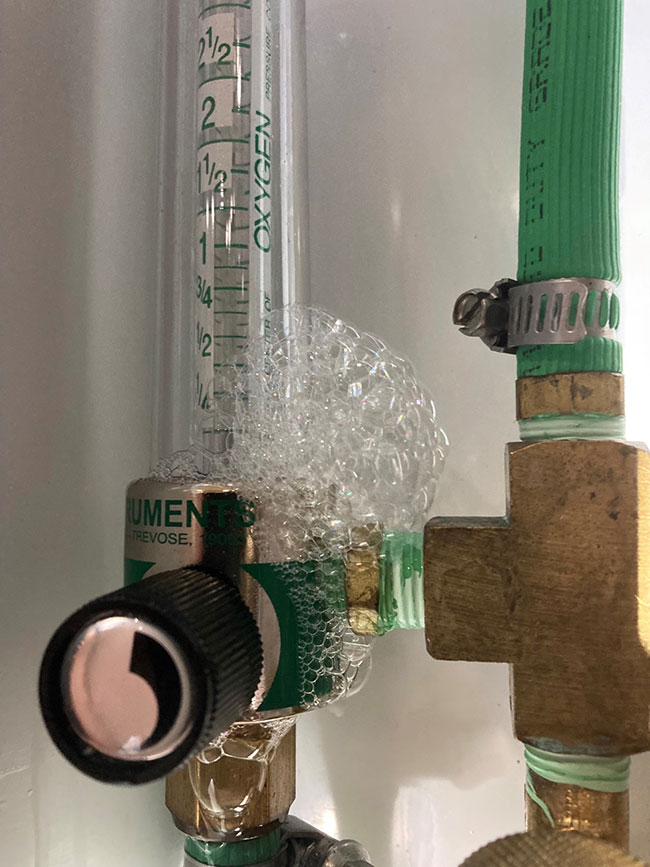
Features
Systems
Technology
Fresh Tips: How to reduce oxygen waste in a RAS system
June 17, 2022 By From the experts at the Freshwater Institute
 Oxygen leak detected using a leak detection solution. Photo: Freshwater Institute
Oxygen leak detected using a leak detection solution. Photo: Freshwater Institute Oxygen represents not only a critical life support input for intensive recirculating aquaculture systems (RAS), but a significant production cost.
Whether using oxygen generators or liquid oxygen, efficient use can help control costs and reduce wear and tear on equipment. In addition, preventing oxygen waste through leaks in supply lines or over supply to RAS can prevent hazards associated with oxygen enriched environments for operators and gas bubble trauma for the fish.
Infrastructure
One way to gauge oxygen use at a facility is by installing oxygen mass flow meters.
Number and placement of meters will depend on the scale and design of the facility. Meters allow operators to compare actual oxygen use to expected use calculations based on biomass density and feeding rate of all the RAS downstream of the meter. Once baseline oxygen use is established, an unexpected increase in use could indicate a problem like a leak or open valve that needs attention.
Strategically placed shut-off valves are important for servicing oxygen supply lines and can be a convenient method to turn off supply to empty RAS between cohorts of fish.
Checking for leaks
Whether troubleshooting unexpected increases in use, or conducting regular inspection protocol, checking for leaks is an important task for RAS facilities.
Leaks often form from corrosion, fittings becoming loose from vibrations, and seals or O-rings wearing out. Leak checks should be performed at least once a year as part of a normal maintenance schedule. When looking for leaks, check each brazed fitting, valve, threaded fitting, barbed fitting, compression fitting, flowmeter, solenoid valve, and any other area that could leak.
There are several different methods for checking for oxygen leaks, a few of which are highlighted.
The first method is a leak detection liquid solution. With the oxygen line pressurized, spray the solution around any fittings or areas likely to leak. If a leak is present, bubbles will form at the leak. The bubbles can take a few seconds up to several minutes to appear depending on the size of the leak. A smaller leak will produce fine bubbles that can create a foam, while a larger leak will create large bubbles.
This is the most affordable method for finding leaks but requires additional labor to clean up the leak detecting liquid. Never use any type of soap and water mixture for oxygen leak detection. Soaps often contain oils and fats that are not safe for use with compressed oxygen.
The second method is an ultrasonic acoustic leak detector. Ultrasonic gas leak detectors detect the oxygen leak by using acoustic sensors to identify fluctuations in noise and convert the ultrasonic waves to an audible sound.
This method of leak checking is more expensive due to the initial cost of the equipment, but requires no clean up. This method also requires the lines to be pressurized and the pressures needed vary depending on which leak detector is being used.
A third method of checking for leaks is a static leak test for 24 hours. This method requires a properly functioning pressure gauge and a way to isolate the line you want to check. Pressurize the line to normal operating pressure and close a valve on each end. If the gauge maintains pressure for 24 hours, there are no leaks present. This method may only be feasible when RAS are not in use.
Management
Accurate and regularly calibrated dissolved oxygen probes are the first prerequisite to effective oxygen management. Accurate monitoring will allow operators to set gas flows to oxygenation equipment that provide adequate dissolved oxygen concentrations in the RAS water without inadvertently oversupplying the culture tank.
Dissolved gas concentrations exceeding 100 per cent saturation in the culture tank can be wasteful and concentrations above 110 per cent are potentially harmful to the fish due to possible gas bubble trauma.
Selecting oxygenation equipment with high transfer efficiency in design phases is important and properly maintaining and operating the equipment ensures continued performance. Equipment should be routinely checked for proper operation, leaks, clogs, damage, water flow rates, and water levels. Incorrectly operated equipment will result in reduced transfer efficiency and require more gas than is necessary to compensate.
Attentive husbandry and observation can give operators a sense of the overall health of the fish and reveal signs of stress. Feeding behaviour should also be noted and wasted feed kept to a minimum.
Finally, a clean RAS where collected solids are regularly flushed from the system will prevent excess growth on system surfaces and pipes. Reducing stress, avoiding overfeeding, and keeping the RAS clean are all ways to reduce oxygen demand in the RAS.
Print this page